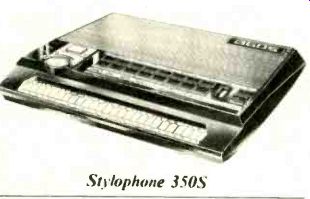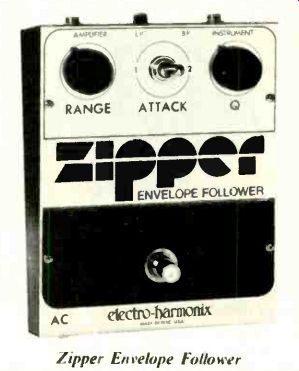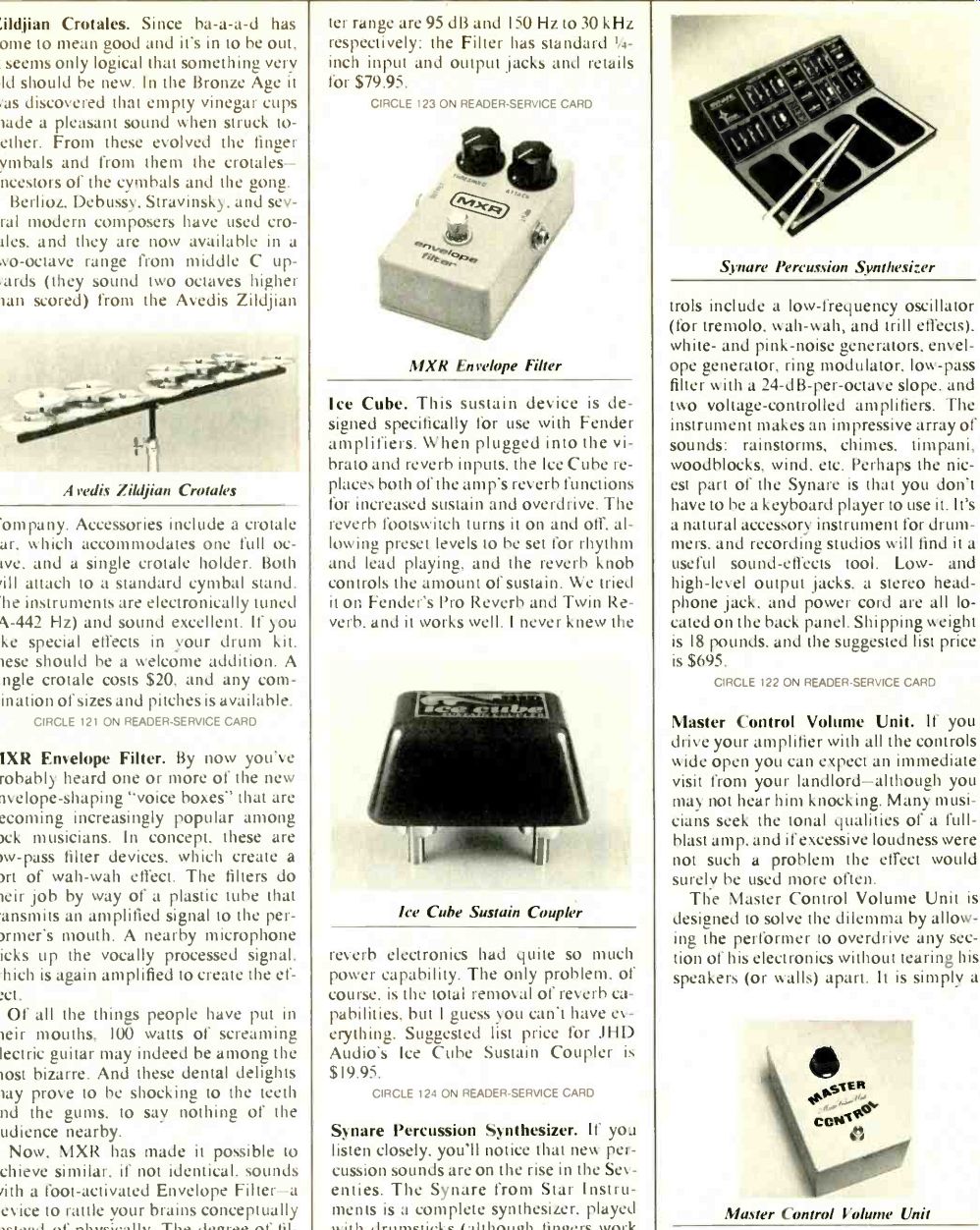Noise Reduction: Choosing Your Options
'Decently, Dolby Laboratories celebrated the tenth anniversary of the famous Dolby "A" Noise Reduction System's public introduction. When first introduced, the gadget was treated with suspicion, but once Ray Dolby convinced the recording industry that noise reduction would not hurt (and this took some doing). the idea caught on quickly.
Now, hardly a day seems to go by with out the announcement of some new sys tem guaranteed to banish noise- or at least reduce it by a few dB.
The significant differences among the various rival systems currently on the market make most of them incompatible one with another. Therefore-unless you're quite well off-you must decide which is best for you. and avoid the others as much as possible.
These systems may be classified as complementary or non-complementary.
The former require that noise reduction be used during recording, and an equal-and-opposite (complementary) system used for playback. The non-complementary system is for playback only. It is the complementary type that causes compatibility problems, for a tape recorded with one manufacturer's system will sound quite strange when played back through another's. It will also sound odd when monitored through no noise reduction setup at all. The tape used may in deed be impressive!' noise-free, but you may not have the equipment to enjoy it.
How do noise reduction systems distinguish signal from-^ise? Quite simply.
they don't. Although you and I know noise when we her:- it, the col:vie:nen tary noise rcchac"^n system cannot tell one from the other. It operates in a man-requiring no brain power-it boosts a f.' ' lw level signals, before they get to th:- ape recorder. Therefore these sig rni!F afe-;lori :It a higher than nor trinl wal "e that of the residual of the tape itself. If this were riTpi_ back dirzetly, the listener would hear a program with a compressed dynamic range and no noise reduction at all. But when the tape is reproduced through the appropriate playback sys tem, the low-level segments of the signal are restored to their proper place. Since the system regards tape noise as just an other low-level signal. it is likewise attenuated-not to its "proper place." but to a level that is perhaps ten or more dB lower than normal. This delightful circumstance occurs because the tape noise was no: processed earlier.
Since the complementary noise reduction system operates by first compressing the dynamic range of the program (be fore recording), and then later expanding the program (before playback). it is often referred to as a "compander" short for compressor/expander-and in compatibility arises from the different means used by different manufacturers to compress and expand.
THE DOLBY A SYSTEM. Dolby feels that a high-level program does not re quire noise reduction: The music itself masks the noise sufficiently. Therefore the system functions only at low levels, in the manner described above. As a further refinement, the signal is first divided into four frequency bands, with each band processed separately. (This is be cause noise within one frequency band may be perceived when the music is, for the most part. within some other frequency range-as may happen. for ex ample. during solo passages.) In a typical situation, this band splitting allows noise reduction to occur at high and low frequencies during the presence of a comparatively high-level signal within the mid-frequency range.
Needless to say. Dolby's A system is not cheap ($795 per channel), and so a B system was developed at a significant reduction in cost. Found mostly as a built in feature in consumer tape recorders and receivers (for Dolby broadcasts), the B operates only in the high-frequency range. where tape and FM hiss is found.
Dolby prerecorded tapes all use the B system.
THE DBX SYSTEM. The rival DBX sys tem operates at once over the entire audio bandwidth and-in addition to raising low-level signals-also brings down high-level signals. Although it may be argued that this additional compression is unnecessary for noise reduction, it does enable the user to accommodate programs with a wider dynamic range, without fear of high-level tape saturation.
DBX has enjoyed considerable success in the semi-pro marketplace, and Teac/ Tascam offers the system as a built-in option in several of its top-of-the-line tape recorders. In addition, there is a small but growing number of DBX-encoded discs on the market, bringing noise reduction to the phonograph record, which in so many cases needs all the help it can get.* Of course, the complementary systems just described will be of no help what ever in reducing the noise on material that was recorded without benefit of noise reduction in the first place. How ever, a non-complementary system may do an impressive job here, and BLAUEN RESEARCH'S DYNAMIC NOISE FILTER 1201A is an excellent example of such a device. The dynamic noise filter takes advantage of the fact that quietly played music usually contains a somewhat reduced upper harmonic structure. In terms of noise reduction, this means that at low levels the audio system's high-frequency response may be attenuated, thereby filtering out the noise without materially affecting the music. However, the device continuously monitors the level music source, rhythm unit. etc.. to creases the filtering action is withdrawn.
At the same time, the music begins masking the noise anyway. Although my brief explanation may not sound entirely convincing, such filtering devices go a long way in improving the apparent noise level of a variety of program sources.
But for professional and semi-pro recording. the complementary systems have become so close to universal that the need for after-the-fact noise elimination has been obviated to a large extent.
JOHN W. ORAM
Stylophone 350S. Originally designed as a child's toy, the Stylophone has grown up into an almost indescribable hybrid.
In one sense, it is still a musical instrument that children can use. But in another-and more important-sense, it has distinctly useful possibilities for both the amateur and the professional musician.
---------------

For more on consumer units. see HF. March 1976 An updated treatment of the subject will appear in a forthcoming issue.
------------
Very simply. it is a three-and-a-half octave monophonic keyboard played with a pencil-shaped stylus (two styli are used for special effects). It has eight preset voices that can be used singly or in any combination to simulate a wide variety of instrumental timbres: it has a choice of fast, slow, or no vibrato, a short and long decay control. and a short and long automatic repeat control. In addition, there is a light-activated photo switch that can be used to regulate vibrato, swell, or wah-wah. There are outputs for external amplification and for the substitution of a pedal for the photo switch, and an input for the addition of a line level music source. rhythm unit. etc.. to be played through the unit's speaker.

Stylophone 350S
The whole package weighs less than five pounds with its two 9-volt batteries, and it's about the size of a small portable typewriter.
How does it work? With unbelievable simplicity and accuracy. You can manipulate the stylus as fast as you can a pencil: a bit of practice with one's free hand over the photo cell can result in an incredible range of both expressive and percussive effects. The woodwind sounds are the best of the tone controls.
but-like most electronic instruments--the Stylophone works best when used to create its own sounds. The manufacturers inform me that David Bowie used the instrument on "Space Oddity." and that most of the studio musicians in Los Angeles are grabbing it up as fast as they can. e talked to several who have used it on gigs or for recording and they seem to find it most useful as a filler and backer- thickening textures, adding color, and putting an unusual bite on the edge of a familiar sound.
I agree. And I also found the wah-wah control particularly effective in creating low-pitched rhythm sounds for over dubbing, and the high woodwind sound almost undistinguishable from a real piccolo. As a film composer who does an awful lot of last minute shifting. changing. overdubbing, and coloration, it seems to me that this little instrument could do a lot of things more easily and more quickly than some of its high priced, admittedly more complex competitors.
And I'll bet the instrument is being used by musicians' kids, too. My four-year old daughter took no longer than ten seconds to figure out how to get some intriguing sounds out of the 3505, and she is now experimenting with it in a way that she never has with either our piano or guitar. No doubt the size and simplicity of operation make it easier for her to exercise her basic creative instincts-and that's all to the good.
Finally, and most remarkable of all, the Stylophone 350S-currently available by mail only-is selling for the quite reasonable price of $200.
-- DON HECKMAN
Zipper Envelope Follower. Electro-Harmonix' new Zipper produces synthesizer-like wah-wah effects in conjunction with guitar. bass. or clavinet. The RANGE control varies the frequency response, Q makes the effect more or less pronounced in relation to the basic sound of the instrument, and a two-position AT TACK switch determines whether the wah-wah will be fast or slow. An adjustment on the back marked LP/BP (low pass/band pass) increases or decreases the high-frequency content of the output signal. Its function is similar to that of a bright switch often found on instrument amplifiers. A foot-activated bypass a …

---- Zipper Envelope Follower
… switch allows the user to return to normal sound at any time.
Field testing showed that the Zipper interfaces well into the audio signal path.
causing none of the usual foot-pedal insertion losses and introducing no un wanted noises. Sturdy construction is not a plus factor here: The bottom of the printed circuit board rests on a piece of Styrofoam. rather than being secured to the housing in any way. The unit can be powered by an internal 9-volt battery or through an optional AC adapter. Input and output connections are via standard 1/4-inch phone jacks, and the suggested list price is $79.95.
Zildjian Crotales. Since ba-a-a-d has come to mean good and it's in to be out, it seems only logical that something very old should be new. In the Bronze Age it was discovered that empty vinegar cups made a pleasant sound when struck together. From these evolved the finger cymbals and from them the crotales ancestors of the cymbals and the gong.
Berlioz, Debussy. Stravinsky, and several modern composers have used crotales, and they are now available in a two-octave range from middle C up wards (they sound two octaves higher than scored) from the Avedis Zildjian Company. Accessories include a crotale bar, which accommodates one full octave, and a single crotale holder. Both will attach to a standard cymbal stand.
The instruments are electronically tuned (A-442 Hz) and sound excellent. If you like special effects in your drum kit, these should be a welcome addition. A single crotale costs $20. and any combination of sizes and pitches is available.

------ Avedis Zildjian Crotales, etc.
MXR Envelope Filter. By now you've probably heard one or more of the new envelope-shaping "voice boxes" that are becoming increasingly popular among rock musicians. In concept. these are low-pass filter devices, which create a sort of wah-wah effect. The filters do their job by way of a plastic tube that transmits an amplified signal to the per former's mouth. A nearby microphone picks up the vocally processed signal, which is again amplified to create the effect.
Of all the things people have put in their mouths. 100 watts of screaming electric guitar may indeed be among the most bizarre. And these dental delights may prove to be shocking to the teeth and the gums, to say nothing of the audience nearby.
Now, MXR has made it possible to achieve similar, if not identical, sounds with a foot-activated Envelope Filter-a device to rattle your brains conceptually instead of physically. The degree of filtering action is determined with the THRESHOLD control: ATTACK varies the onset of the effect.
Sturdy and reliable construction is a plus factor: the Envelope Filter sounds good. is almost noise-free. and won't shake your teeth loose. Dynamic and filter range are 95 dB and 150 Hz to 30 kHz respectively; the Filter has standard 1/4-inch input and output jacks and retails for $79.95.
MXR Envelope Filter Ice Cube. This sustain device is de signed specifically for use with Fender amplifiers. When plugged into the vibrato and reverb inputs, the Ice Cube replaces both of the amp's reverb functions for increased sustain and overdrive. The reverb footswitch turns it on and off. al lowing preset levels to be set for rhythm and lead playing, and the reverb knob controls the amount of sustain. We tried it on Fender's Pro Reverb and Twin Reverb. and it works well. I never knew the Ice Cube Sustain Coupler reverb electronics had quite so much power capability. The only problem. of course, is the total removal of reverb capabilities. but I guess you can't have everything. Suggested list price for JHD Audio's Ice Cube Sustain Coupler is $19.95.
---- MXR Envelope Filter (see above)
Synare Percussion Synthesizer. If you listen closely, you'll notice that new percussion sounds are on the rise in the Seventies. The Synare from Star Instruments is a complete synthesizer, played with drumsticks (although fingers work too). Four rubber pads-they look like practice pads-act as separate controllers. and each has three zones for pitch, tone color, and dynamics. The synthesizer itself contains a voltage-controlled oscillator that generates sawtooth, square, or pulse waveforms. Other controls include a low-frequency oscillator (for tremolo, wah-wah, and trill effects), white- and pink-noise generators. envelope generator, ring modulator, low-pass filter with a 24-dB-per-octave slope, and two voltage-controlled amplifiers. The Instrument makes an impressive array of sounds: rainstorms, chimes, timpani, woodblocks, wind, etc. Perhaps the nicest part of the Synare is that you don't have to be a keyboard player to use it. It's a natural accessory instrument for drummers. and recording studios will find it a useful sound-effects tool. Low- and high-level output jacks, a stereo head phone jack, and power cord are all located on the back panel. Shipping weight is 18 pounds, and the suggested list price is $695.
------- Synare Percussion Synthesizer (see above)
Master Control Volume Unit. If you drive your amplifier with all the controls wide open you can expect an immediate visit from your landlord-although you may not hear him knocking. Many musicians seek the tonal qualities of a full-blast amp. and if excessive loudness were not such a problem the effect would surely be used more often.
The Master Control Volume Unit is designed to solve the dilemma by allowing the performer to overdrive any section of his electronics without tearing his speakers (or walls) apart. It is simply a variable resistor, with foot-activated by pass. and is inserted between the power amplifier and the speakers. The device comes equipped with standard 1/4-inch phone jacks for input and output and costs $60.
FRED MILLER
------ Master Control Volume Unit (see above)
(High Fidelity, May. 1977)
Also see: